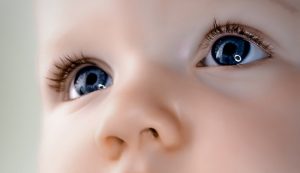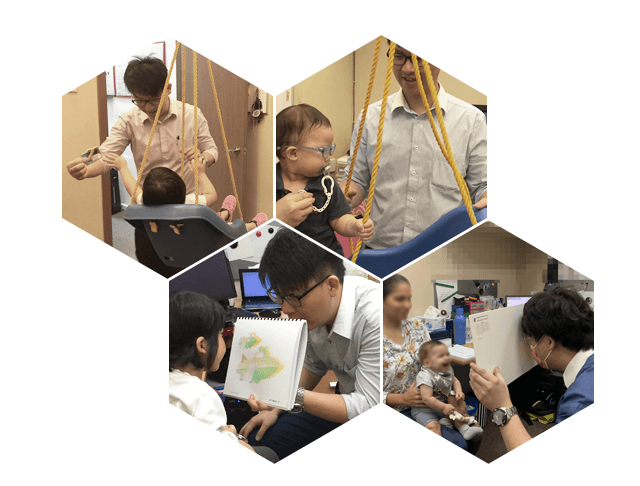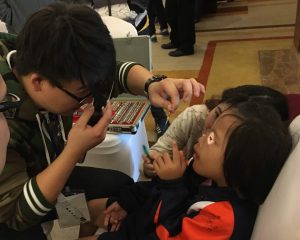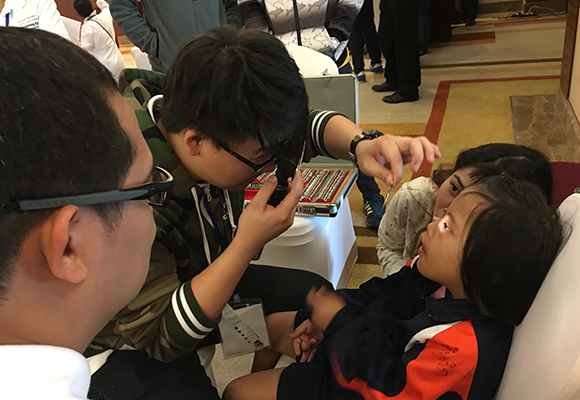
Parents' Guide To Children's Normal Visual Development From Infancy To Preschool
Normal Visual Development Excerpted from: A Reference Guide for Preschool Children's Vision Development ©"", 1995
More than 98% of all infants are born with normal, healthy seeing organs -- the eyes. Many authorities believe this high rate of normalcy occurs because the eyes and the entire visual system are so important to humans.
However, the normal health and structure of the eyes do not guarantee that your child will be able to use those eyes efficiently in the world he must see and interpret. The classroom, into which your child enters around the age of six, demands much of a child's vision. This classroom, and its special tasks, demands visual abilities and skills every child must learn before he enters school if he is to be successful there. These abilities and skills are learned much better by your preschool child when you (and all others caring for your child) know how to evaluate your child's progress, and how to guide and assist this vision development for future academic success.

This Parents' Guide is designed to give you enough information about visual development so you can make intelligent observations, and know when, where, and how to help your preschool child. The Parents' Visual Development Checklist for Preschool Children, below can help you know where a child is on the scale of developing necessary visual skills. Because the sequence of child development is more important than the age at which a given skill developed, all ages given on the checklist are approximate. If your child lags behind the scale by more than four to six weeks in the time from birth to age two, professional help should be sought to assure your child's successful performance in his academic future. Referrals to eye doctors who specialize in children's visual development can be obtained through this site by visiting our Referral Directory: Find a Pediatric Eye Doctor.
To Observe The Appearance And Use of The Eyes General Notes to Consider Before Going Through the Checklist: Most of the conditions or behaviors noted below will catch your attention. However, none of these conditions should ever be allowed to continue. Children do not "outgrow" developmental delays or gaps. The basic physical condition of the eyes must be normal, and the eyes healthy, if your preschooler is to develop the visual skills necessary for achievement in the classroom.
If any one of these developmental activities is omitted or practiced too briefly by your baby, it is important to watch all other developmental signs to be certain your baby is gaining all the skills he needs. Delay in visual development can interfere with total development because of the close interrelationships between all sensory systems (sensory-motor integration).

SPECIAL NOTE: Parents frequently become alarmed when they see one of their child's eyes appearing to turn in (deviating) toward the child's nose. When the child is very young, and the bridge of the nose is still very flat and broad and this can give a false appearance of a crossed-eye (pseudostrabismus). Look carefully at pictures of your child, and if the reflections of the camera flash bulb are centered in the pupil (the black, round center of each eye), there is probably little cause for concern. However, if this reflection is not in the center of the eye, professional attention should be sought immediately because children seldom outgrow vision problems without professional assistance. Do not hesitate to get several opinions before anything as radical as eye muscle surgery is recommended for your child at these early ages. There are several proven clinical (non-surgical) procedures to alleviate most of these problems, and surgery should always be the last resort. To learn more about eye muscle surgery for eye deviations go to our page on Eye Turn, Lazy Eye (Amblyopia, Mata Malas 懒惰眼).
Parents' Preschool Visual Development Checklist
Vision (visual development) milestones according to age
Frequently Asked Questions
Vision development begins in the womb and continues throughout childhood and adolescence.
The development of a mature visual system is especially critical within the first six years of life.
The first six years of life is considered the “vulnerable period” because it is a time when the child’s development is most vulnerable to the effects of the various threats to their eye health and vision. Any change in vision or ocular health can inhibit a child from developing the necessary visual skills, and cause developmental delays.
An infant’s eyes are examined by the neonatal pediatrician soon after birth to rule out any of the common postpartum eye diseases such as cataracts, infantile glaucoma, and eye tumors.
The recommended schedule of eye exams for children includes:
- One visit between 6-12 months
- One visit between 2-3 years old
- One visit between 4-5 years old
- Annual visit, from 6 years and up
Young children may not report if they feel that something is wrong— simply because they don’t realize that something is wrong!
Parents play a vital role in their child’s healthy development of vision. It is therefore important for parents to:
- Watch for signs of a vision problem
- Schedule their first eye exam at around 6 months of age
- Follow your eye doctors advice on an appropriate schedule of eye exams
- Engage in parent-play age-appropriate activities that can stimulate your child’s vision, such as swing mobiles, soft toys, and playful games
- Allow children to safely explore and interact with their natural environment, such as playing in a sandbox or climbing a tree
- Provide challenging physical experiences, such as riding a tricycle and catching balls
- Increase the visual demand of play and activities, such as sports and flashcards
If you think your child may not be responding to their environment appropriately, or you notice that your child is not reaching an important developmental milestone, schedule an eye exam to rule out any vision problems.
If an issue with the development of their visual system is detected, try not to worry— your eye doctor will advise you on the most appropriate treatment plan for your child, to facilitate the best possible way to help them achieve their visual developmental milestones.
Source Link: optometrists/vision-development/


